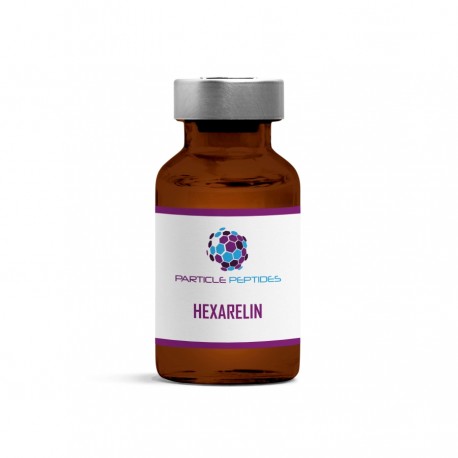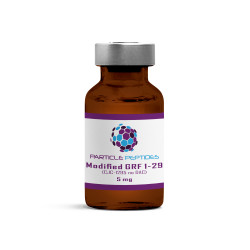Description of Hexarelin
A synthetically produced peptide hexarelin was developed in the early 1990s by Italian pharmaceutical company Mediolanum Farmaceutici as a part of research aimed to find compounds able to stimulate the release of GH from pituitary gland. From that time it was a part of numerous researches for example on cardiostimulating and cardioprotecting effects. There was also anti-atherosclerotic activity of hexarelin observed in particular rat study, where this peptide suppressed formation of atherosclerotic plaques and neointima. Hexarelin also decreased calcium sedimentation specifically in aortic wall, and decreased cholesterol levels in obese rats. Let us now bring you some more information on hexarelin research topics.
[13]
Research Confirmed Effects
1. Hexarelin in Heart Protection
Hexarelin has shown cardioprotective effects in rat models of myocardial ischemia/reperfusion (I/R) injury achieved through binding to growth hormone secretagogue receptor (GHSR) and receptor CD36. Treatment with hexarelin showed improvements in cardiac systolic function, a decreased level of malondialdehyde (a marker for oxidative stress), and a greater number of surviving cardiomyocytes compared to those treated with saline. The beneficial effects of hexarelin treatment were also shown to be slightly superior to those of equimolar ghrelin treatment.
Another study focused on the impact of hexarelin on male ghrelin-knockout mice after myocardial infarction, providing further evidence of its cardioprotective properties. Hexarelin significantly reduced the mortality rate within 2 weeks compared to a control group, and improved various cardiac function parameters, such as ejection fraction and peak rates of pressure rise and decline. This effect on cardiac function, along with reduced heart cell death, was achieved by binding to GHSR and preventing apoptosis. Moreover, hexarelin treatment was also here shown to be more effective than ghrelin treatment in terms of heart function improvements.
In a study investigating its therapeutic role, rats with CAL-induced heart failure were treated with subcutaneous injections of hexarelin or saline. The results showed that hexarelin treatment significantly improved LV function, reduced oxidative stress, and ameliorated myocardial remodeling.
In both mouse and rat models of heart disease a study examining its impact on myocardial infarction (MI), hexarelin treatment resulted in improved left ventricular function, reduced cardiac fibrosis, and a decrease in interstitial collagen deposition. This cardioprotective effect was also observed in spontaneously hypertensive rats (SHRs), where hexarelin treatment reduced left ventricular hypertrophy, improved cardiac function, and lowered blood pressure. The mechanism behind these benefits appears to be related to hexarelin's ability to modulate the expression of growth hormone secretagogue receptor (GHSR) and its impact on collagen synthesis and degradation.
Hexarelin's effects on cardiac function and fibrosis are accompanied by a shift from sympathetic to parasympathetic nervous system activity, leading to lower heart rates and reduced blood pressure. This shift helps reduce myocardial remodeling and supports overall cardiac health.
[1] - [5]
2. Hexarelin and Its Cardioprotective Effects in Diabetic Rats
Thus hexarelin has demonstrated significant cardioprotective effects in various models of heart disease, whereas in one study, it was shown to improve cardiomyocyte function in streptozotocin-induced diabetic rats. This improvement was achieved by reversing changes in cardiomyocyte contraction and intracellular calcium ([Ca2+]i) transients, which are commonly disrupted in diabetic conditions. Additionally, hexarelin treatment corrected the abnormal action potential duration and transient outward potassium current (Ito) density seen in diabetic cardiomyocytes. The treatment was also associated with antiapoptotic changes, with upregulated GHSR expression and altered expression of apoptosis-related proteins, such as Bax, Bcl-2, caspase-3, and caspase-9. This suggests that hexarelin may hold therapeutic potential for managing cardiac dysfunction in diabetic patients.
[6] - [8]
3. Hexarelin and Improved Fat Measures
Hexarelin seems to haveo potential also in improving lipid metabolic aberrations in nonobese insulin-resistant male mice. In a study mice were given twice-daily intraperitoneal injections of hexarelin for 12 days, resulting in notable improvements in glucose and insulin tolerance, alongside decreased plasma and liver triglycerides. These benefits are thought to be connected to hexarelin's ability to enhance adipocyte differentiation and improve lipid metabolism in white adipose tissue. Although hexarelin-treated mice exhibited increased food intake, it did not affect their total body weight. In fact, hexarelin treatment was associated with decreased fat mass and increased lean mass, suggesting that it corrected the abnormal body composition often linked to insulin resistance and metabolic syndrome.
[9]
4. Hexarelin and Muscle Protection
Furthermore, the peptide has been found to protect skeletal muscle from mitochondrial damage in rat models of cisplatin-induced cachexia, a common side effect of cancer chemotherapy. Cachexia is characterized by weight loss and muscle atrophy, and cisplatin treatment can cause a decrease in mitochondrial biogenesis, mass, and fusion index, along with increased oxidative stress. Studies showed that hexarelin could reverse these detrimental effects by antagonizing chemotherapy-induced mitochondrial dysfunction. This suggests that targeting mitochondrial health might be an effective strategy to mitigate muscle wasting in cachexia.
In addition to its impact on mitochondria, hexarelin has also demonstrated beneficial effects in preventing dysregulation of skeletal muscle calcium homeostasis in rat models. This dysregulation contributes to muscle atrophy and is associated with altered calcium signaling pathways. Cisplatin-treated rats displayed reduced muscle weight, smaller fiber diameter, increased intracellular calcium levels, and decreased calcium transients. Hexarelin treatments helped normalize calcium homeostasis, preserving muscle function and reducing atrophic indicators.
[10], [11]
References
- E. Agbo et al., “Modulation of PTEN by hexarelin attenuates coronary artery ligation-induced heart failure in rats,” Turk. J. Med. Sci., vol. 49, no. 3, May 2019. [PubMed]
- H. McDonald et al., “Hexarelin treatment preserves myocardial function and reduces cardiac fibrosis in a mouse model of acute myocardial infarction,” Physiol. Rep., vol. 6, no. 9, p. e13699, 2018. [PubMed]
- X. Xu et al., “Chronic administration of hexarelin attenuates cardiac fibrosis in the spontaneously hypertensive rat,” Am. J. Physiol. Heart Circ. Physiol., vol. 303, no. 6, pp. H703-711, Sep. 2012. [PubMed]
- X. Zhang, L. Qu, L. Chen, and C. Chen, “Improvement of cardiomyocyte function by in vivo hexarelin treatment in streptozotocin-induced diabetic rats,” Physiol. Rep., vol. 6, no. 4, 2018. [PubMed]
- Y. Mao, T. Tokudome, I. Kishimoto, K. Otani, M. Miyazato, and K. Kangawa, “One dose of oral hexarelin protects chronic cardiac function after myocardial infarction,” Peptides, vol. 56, pp. 156–162, Jun. 2014. [PubMed]
- Y. Ma, L. Zhang, J. N. Edwards, B. S. Launikonis, and C. Chen, “Growth hormone secretagogues protect mouse cardiomyocytes from in vitro ischemia/reperfusion injury through regulation of intracellular calcium,” PloS One, vol. 7, no. 4, p. e35265, 2012. [PloS One]
- R. Mosa et al., “Hexarelin, a Growth Hormone Secretagogue, Improves Lipid Metabolic Aberrations in Nonobese Insulin-Resistant Male MKR Mice,” Endocrinology, vol. 158, no. 10, pp. 3174–3187, 01 2017. [PubMed]
- G. Sirago et al., “Growth hormone secretagogues hexarelin and JMV2894 protect skeletal muscle from mitochondrial damages in a rat model of cisplatin-induced cachexia,” Sci. Rep., vol. 7, Oct. 2017. [nature.com]
- E. Conte et al., “Growth hormone secretagogues prevent dysregulation of skeletal muscle calcium homeostasis in a rat model of cisplatin-induced cachexia,” J. Cachexia Sarcopenia Muscle, vol. 8, no. 3, pp. 386–404, Jun. 2017. [PubMed]
- Torsello, Antonio & Bresciani, Elena & Tamiazzo, Laura & Bulgarelli, Ilaria & Caporali, Simona & Moulin, Aline & Fehrentz, jean-alain & Martinez, Jean & Perissoud, Daniel & Locatelli, Vittorio. (2008). Novel potent and selective non-peptide ligands of ghrelin receptor : characterization of endocrine and extraendocrine actions. [Research Gate]
- Yuanjie Mao, Takeshi Tokudome,1 and Ichiro Kishimoto, „The cardiovascular action of hexarelin,“ [PubMed]
- Torsello, Antonio & Bresciani, Elena & Tamiazzo, Laura & Bulgarelli, Ilaria & Caporali, Simona & Moulin, Aline & Fehrentz, jean-alain & Martinez, Jean & Perissoud, Daniel & Locatelli, Vittorio. (2008). Novel potent and selective non-peptide ligands of ghrelin receptor : characterization of endocrine and extraendocrine actions. [Research Gate]
- Yuanjie Mao, Takeshi Tokudome, and Ichiro Kishimoto, „The cardiovascular action of hexarelin.“ [PubMed]
 Longevity and Anti-aging Research
Longevity and Anti-aging Research
 Weight Loss Research
Weight Loss Research
 Sleep Enhancement Research
Sleep Enhancement Research
 Muscle Growth research
Muscle Growth research
 Healing and Regeneration research
Healing and Regeneration research













